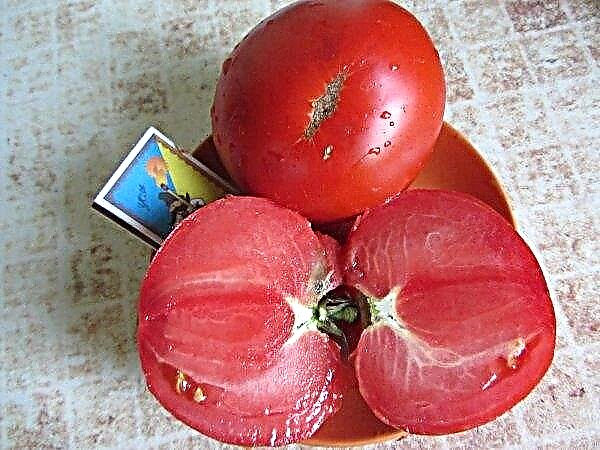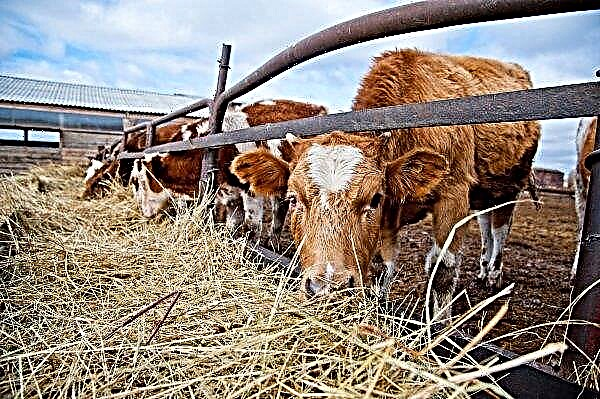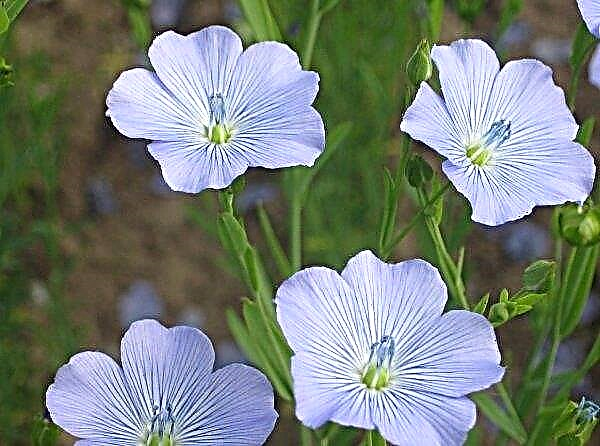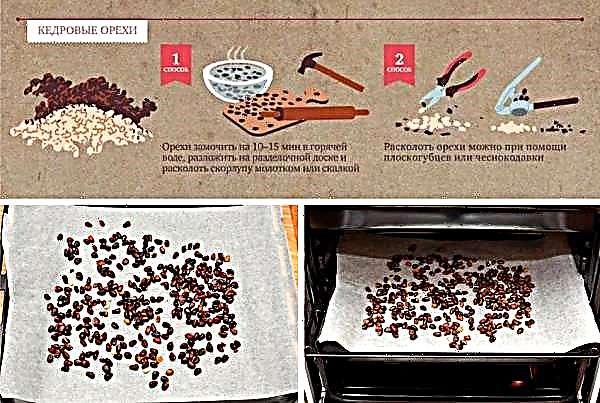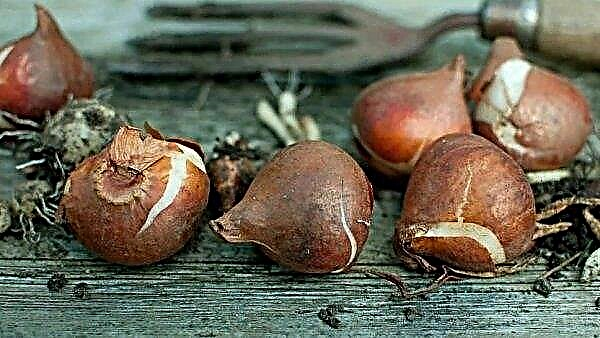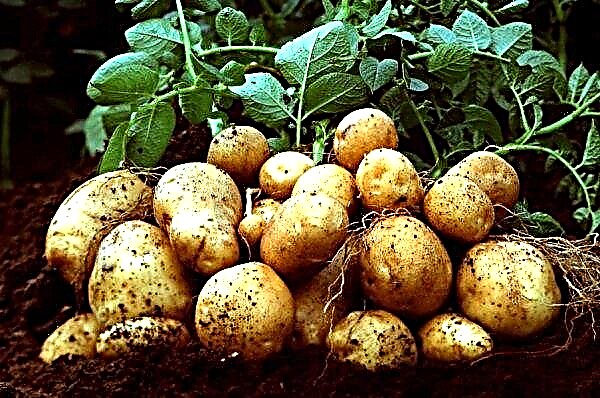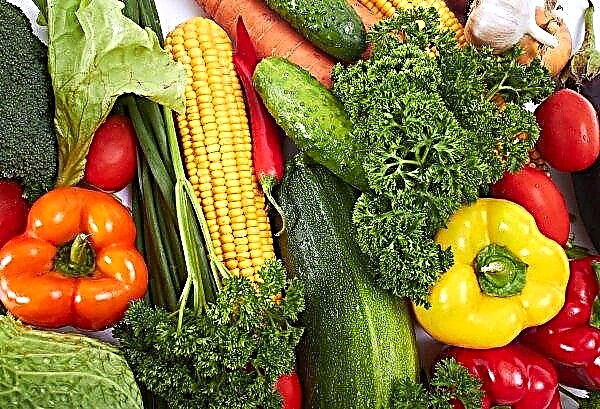Cucumber is one of the most common vegetables in the world. Despite the many existing varieties, breeders are creating more and more perfect - disease-resistant and productive. Variety Tumi F1 - one of these. Read about the features of its cultivation in the review.
Characterization and description of the variety
The Tumi F1 variety was bred by Dutch breeders of Enza Zaden Beheer B.V. It was entered in the state register of the Russian Federation in 2015. Its main feature is resistance to various climatic manifestations; therefore, the variety can be grown in any regions, including both southern and northern.
Did you know? Maximum fruiting occurs in the first ripening wave. — 40 days after emergence. Further, the Tumi F1 variety continues to bear fruit, but in smaller quantities.
Variety characteristic:
- basic: medium early, lettuce, self-pollinating (parthenocarpic) cucumber hybrid of the first generation with good fruiting;
- maturation: on 38–42 days after the appearance of sprouts;
- yield potential: high, about 13 kg / m²;
- disease resistance: high to cladosporiosis and powdery mildew.

Features of the bush and fruits
Bushes are formed by medium-length vines. At the same time, the main lash gives the main crop, and the creation of additional lateral processes can increase productivity by 20-30%. The plant forms female-type flowers. Often they grow in bunches, 2 per node.
Characteristics of a cucumber plant:
- bush: medium-branched, with strong lashes, indeterminate;
- leaves: dark green, small;
- fetus: short, cylindrical, small tuberous;
- coloring: green, with a lighter spot and stripes at the ends;
- peel: slightly rough, with white spikes;
- fetal weight: 120-150 g;
- the size: 15 cm;
- pulp: bitterness, aromatic.
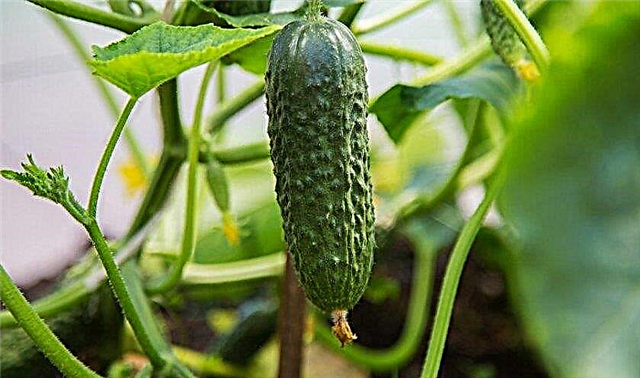 Zelentsy are resistant to yellowing and deformation. The variety is loyal to cool weather and temperature extremes.
Zelentsy are resistant to yellowing and deformation. The variety is loyal to cool weather and temperature extremes.Fruitfulness
Due to the branching of the bush, Tumi is extremely yielding. The originator declared a yield of 13 kg / m², gardeners achieve results of 20 kg / m². On average, one bush per season can bring up to 6 kg of fruit. The variety is characterized by the friendly ripening of vegetables.
Ripening and flowering periods
Cucumbers come from the tropics, although they have adapted to more moderate temperatures. But this does not stop them from ripening quite early. Tumi refers to mid-season varieties. Its fruits fully ripen in 38–40 days after the appearance of the first sprouts, but they can be eaten before.
Important! With a decrease in air temperature below + 15 ° C plants «freeze» in growth. A distinctive feature of Tumi is that he does not shed ovaries in such a situation.
Sowing seeds in the soil should be carried out:
- in the northern regions - in late May or early June;
- in the middle zone of Russia - in the first decade of May;
- on South - in the last decade of April.
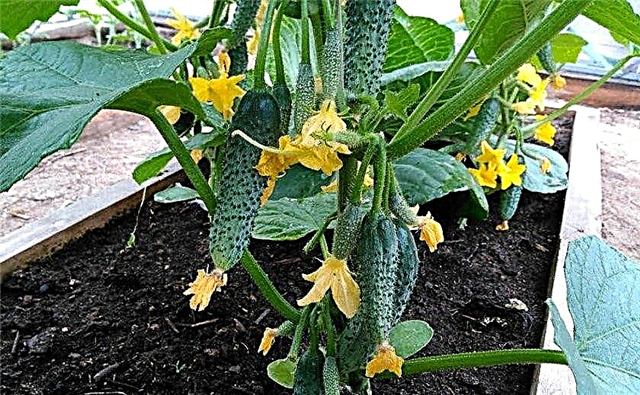 Shoots will appear on about 5 days, but the plants will bloom in 20–25 days. To accelerate fruiting, in regions where there is a large gap between day and night temperatures, plants must be covered with a film or shelter of agrofibre at night.
Shoots will appear on about 5 days, but the plants will bloom in 20–25 days. To accelerate fruiting, in regions where there is a large gap between day and night temperatures, plants must be covered with a film or shelter of agrofibre at night.Advantages and disadvantages
- Grade advantages:
- resistant to cool weather;
- grows both in the greenhouse and in the ground;
- high yielding;
- has a long fruiting period;
- bears fruit "in unison";
- has good transportability and durability;
- resistant to cladosporiosis and powdery mildew.
- The disadvantages of the variety:
- Tumi is a hybrid, so collecting seeds at home is not advisable - their characteristics will not coincide with the parent cucumber;
- the fruits are large enough, reach 15 cm, so it is advisable to collect them regularly to prevent overgrowing.
Did you know? Cucumbers began to be cultivated in India and Mesopotamia 6,000 years ago. According to Indian legend, there are exactly 60,000 seeds in a cucumber, just as many children were from the Raja, to whom they attribute "opening" cucumber as a vegetable crop.
Preparation and sowing technology
Cucumbers can be planted both by direct sowing of seeds in the ground, and seedlings. It is allowed to grow in a greenhouse and in open ground. Seeds are sown both dry and sprouted. The choice of methods depends on the personal preferences of the farmer.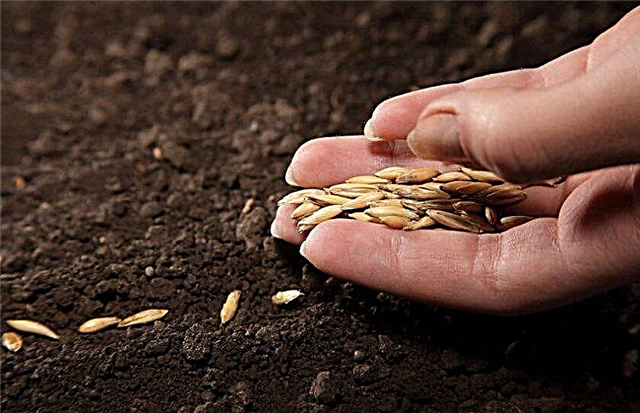 Cucumbers are photophilous enough, therefore, regardless of the choice of the method of sowing, for cultivation you will need a well-lit area, drained fertile soil and regular watering.
Cucumbers are photophilous enough, therefore, regardless of the choice of the method of sowing, for cultivation you will need a well-lit area, drained fertile soil and regular watering.
Optimum conditions for the growth of Tumi varieties:
- air temperature - + 21 ° ... + 23 °;
- humidity - 60%;
- illumination - a site with a bright sun;
- watering - once every 5 days;
- loosening - a day after watering;
- top dressing - mandatory in the phase of growth, flowering, fruiting.
Cucumber is thermophilic. Therefore, depending on the climatic features of the region, the timing of planting seeds will differ. In temperate zones, cucumbers are planted in ridges in May, from the beginning to the middle of the month.
In areas with colder climates - from the end of May until the 10th of June. Planting cucumber seeds at a later date is not worth it - the culture does not tolerate heat. And this can affect the formation of the fruit.
In the open ground
Sowing begins with the preparation of seeds, soil and containers for seedlings, if you want to speed up the time of getting the first greenery.
Seed preparation includes:
If stable, warm weather is established with night temperatures not lower than + 15 ° C, the seeds are sown in the ground. If the soil to be sown is poor in composition, then after digging the site and removing weeds, fertilizers are applied. These can be substances of both organic and inorganic origin. The application rate for manure is 5 kg / m².
If possible, ridges form from north to south. This provides the best lighting for every plant. An excellent option for the borage are "warm" ridges 25 cm high. They consist of several layers. One of them is rotted manure with the addition of ash. He creates a kind of thermal cushion. Plants on such a pillow grow faster and bear fruit more actively.
Seeding technique:
- In the prepared ridge, dig holes. The interval between them is 50-60 cm. The seed planting depth should be 1-2 cm.
- Before sowing, warm water is added to the hole, and then 3 seeds are placed in each.
- Top holes sprinkled with a 3-cm layer of soil.
To smooth the difference between day and night temperatures, a film cover is made for the cucumbers. In it, the temperature will be higher, especially at night.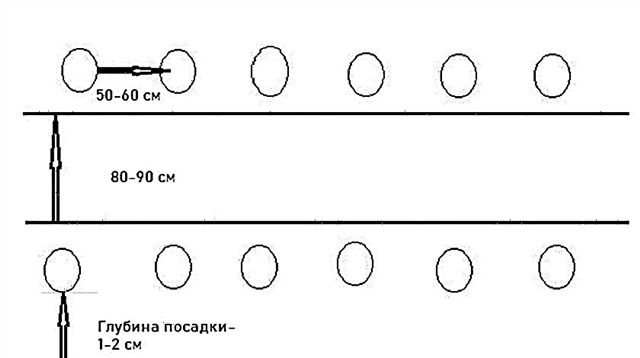 The greenhouse effect enhances the germination and development of cucumber plants. The sprouted shoots are also covered with a film layer. If they are not covered, then the leaves quickly coarse and lose moisture.
The greenhouse effect enhances the germination and development of cucumber plants. The sprouted shoots are also covered with a film layer. If they are not covered, then the leaves quickly coarse and lose moisture.
In the greenhouse
Growing greenhouse cucumbers is not difficult. In the fall, they carry out disinfection of the greenhouse, wash the inventory. The soil is loosened in the same way as in the beds. And then they fertilize and plant seeds. Landing is carried out in a trench way. The ditches are made 30 cm deep and filled up to half with manure, and on top they cover with soil. In addition, you can take care of the trellis, to which the cucumbers will be tied, when the length of the lashes exceeds 0.5 m.
Did you know? The ancient Romans were the first to pickle cucumbers. They are — authors of the first marinade recipes.
Care Features
Care consists of:
- regular watering;
- weed removal;
- fertilizer application;
- mulching;
- stepchildren.
Cucumbers are watered under the root with water of "summer" temperature. On the second day after watering weed borage, removing weeds. Weeding must be done carefully so as not to damage the superficial root system.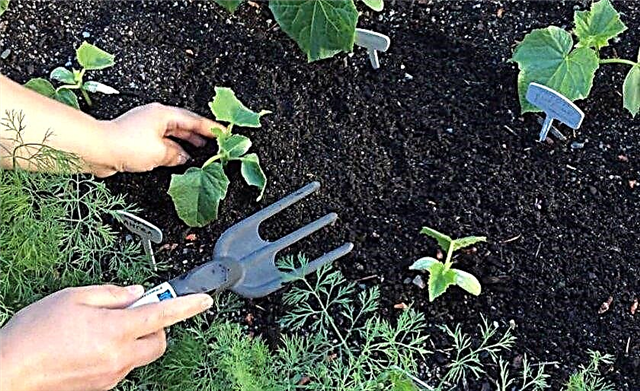 Some gardeners use row spacing mulching to prevent the soil from drying out quickly and stop weed growth. Dry leaves, wood chips or other materials are used as mulch, laying them in an even layer 3-5 cm thick.
Some gardeners use row spacing mulching to prevent the soil from drying out quickly and stop weed growth. Dry leaves, wood chips or other materials are used as mulch, laying them in an even layer 3-5 cm thick.
Watering and fertilizing
Proper care of cucumbers is compliance with the irrigation regime and the correct microclimate. Water should be warm (+ 20 ° ... + 25 ° C). It will be useful to water the cucumbers with rainwater. In periods of too hot weather, when the soil is overheated, it is recommended to water it with cool water. The best type of irrigation is drip.
At the same time, water slowly moistens the soil, soaking it near the roots is very high quality. Watering is carried out as the land dries up, approximately 1 time in 5 days. Water consumption - 8–9 liters per 1 m² for the entire period of bush growth. When cucumbers begin to bloom, watering is performed 1 time in 7 days. In the phase of development of Zelentsy, it is again made more frequent - once every 3 days. Water consumption increases to 25 liters per 1 m².
Important! With irregular watering, cucumbers begin to bitter. And with a lack of moisture, they become shallow and deformed.
This is due to the fact that the cucumber is more than 86% water and for good fruiting, he definitely needs a lot of liquid. In hot weather, without rain, to increase the humidity of the air, water containers are placed between the rows of bushes. During rains, watering is reduced and watered as the soil dries. By the end of summer they irrigate less, not only because the main crop is harvested. Nights become cooler and moisture evaporates less.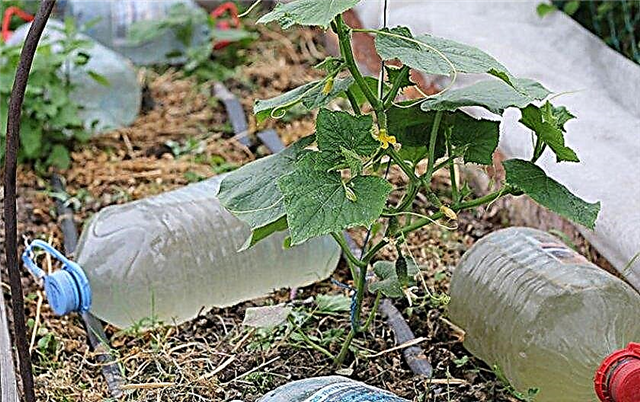 Nutrient soil is important for cucumbers. In household plots, as well as in fields, soils are depleted by the long-term cultivation of various crops. To restore soil fertility, fertilizers are applied. There are fertilizers of organic and inorganic origin. Each species has its own merits. So, organics are animal and vegetable products: manure, meat and bone meal, peat, straw, green manure, algae, ash.
Nutrient soil is important for cucumbers. In household plots, as well as in fields, soils are depleted by the long-term cultivation of various crops. To restore soil fertility, fertilizers are applied. There are fertilizers of organic and inorganic origin. Each species has its own merits. So, organics are animal and vegetable products: manure, meat and bone meal, peat, straw, green manure, algae, ash.
They decompose gradually, which is good to ensure stable plant growth. Inorganic fertilizers are obtained from minerals by chemical reactions or the influence of natural processes. - weathering, exposure to water or volcanic activity. Fertilizers of this group are represented by granules, powders or aqueous solutions. They are quickly absorbed.
Therefore, they are used if you need to quickly increase the nutritional value of the soil. When planting, it is preferable to use rotted manure. It is a source of nitrogen, a trace element necessary for the vegetation of a cucumber plant. Ash is added to it. It is a source of potassium, which is necessary for intercellular metabolism in plant tissues.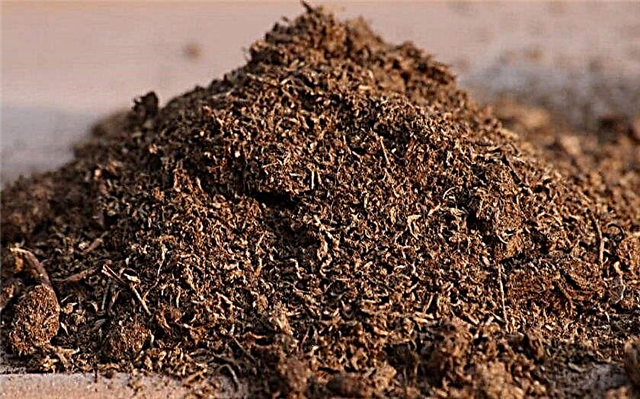 The manure application rate is 5 kg / m².
The manure application rate is 5 kg / m².
If you prefer inorganic fertilizers, the composition may look something like this:
- nitrogen - 30 g per m²;
- potassium - 45 g per m²;
- phosphorus - 12 g per m².
Garter and bush formation
Cucumbers are creepers that grow in the warm season in our climate. For convenience, they need to provide support. The stems in each internode have special antennae for attachment to the supports. With their help, the plant climbs to any height.
Important! It is forbidden to trim before the stems reach a height of half a meter. If an underdeveloped plant is cut, it can refuse to bear fruit and discard the color.
The task of tying is to lighten the weight of the fruit, which the cucumber whip should hold. The fixing structure may be a pole, horizontal or vertical trellis, grate, small fence or hedge. Garter is needed after the shoots reach a length of 0.5 m and is carried out as the plant grows. 3-5 weeks after planting the cucumbers in the ground and the beginning of growth, the time for pruning comes.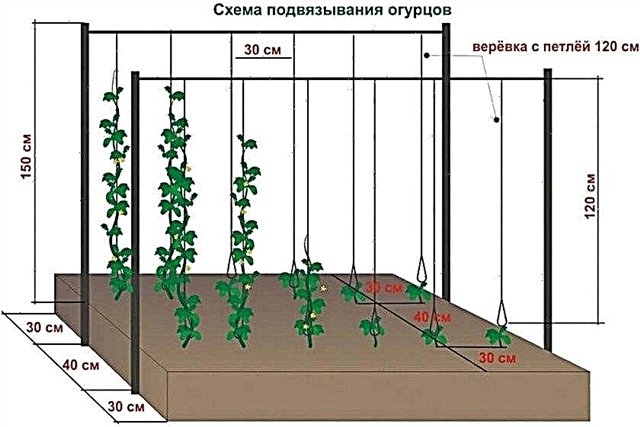 The scheme of tying cucumbers. The length of the stems will be at least 0.5-0.6 m. Side stepsons, unnecessary leaves, damaged parts of plants are subject to removal. Cucumber is formed into one stalk, which is wrapped around a support. Lateral shoots are removed by pinching over the first leaf and the first ovary in the lower part of the plant. In the middle, leave 2 sheets and 2 ovaries, and in the upper part leave 3 sheets and 3 ovaries. A side shoot is performed at an angle of 45 degrees.
The scheme of tying cucumbers. The length of the stems will be at least 0.5-0.6 m. Side stepsons, unnecessary leaves, damaged parts of plants are subject to removal. Cucumber is formed into one stalk, which is wrapped around a support. Lateral shoots are removed by pinching over the first leaf and the first ovary in the lower part of the plant. In the middle, leave 2 sheets and 2 ovaries, and in the upper part leave 3 sheets and 3 ovaries. A side shoot is performed at an angle of 45 degrees.
Soil care
The soil under the cucumbers must be loosened and weed from weeds with a frequency of 5-10 days. Processing is carried out with a garden hoe, deepening it no more than 5 cm, so as not to damage the roots of cucumber plants. Weeding is carried out as weeds appear, and loosening is carried out after rain or watering.
If there is mulch on the ground, then the weeds do not grow, the soil does not compact and does not require loosening. This is practical, especially if the gardener does not have enough time for additional actions on his site. During the summer, the mulch will have to be periodically updated, since the lower layer will decompose, enriching the soil with humus.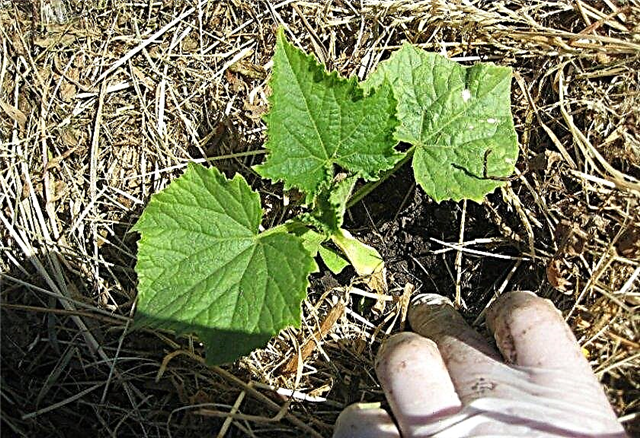
Pest and Disease Control
Major plant diseases occur due to improper air exchange and moisture. Thickened plantings create excellent conditions for the life of insects and the growth of fungi. Humid air after rain will contribute to their development. Therefore, farmers begin planning borage with the choice of varieties for planting with the study of resistance to diseases of one variety or another.
Tumi is resistant to cladisporiosis and powdery mildew. Farmers also note its resistance to other fungal diseases. The manifestation of diseases is accompanied by spots on the leaves or fruits, rotting, wilting. In this situation, crops are treated with fungicides. Most often, these are solutions based on copper - Bordeaux liquid 1% or copper sulfate. Copper ions form a protective layer that destroys pathogens.
The main diseases:
- Alternariosis or dry spotting - a fungal disease that manifests itself in small brown spots (2 cm) on the leaves. It develops at high temperature and humidity. For treatment, double spraying with Bordeaux liquid is recommended with an interval of 10 days.
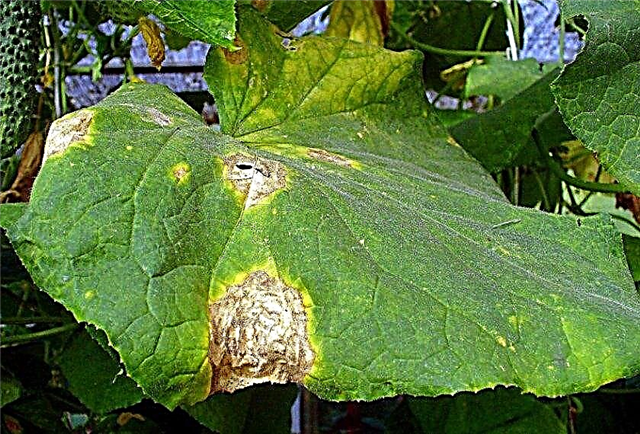
- Anthracnose - It is also a disease of fungal nature, in which yellow and light brown spots appear on the leaves. The conditions for the development of the fungus and its treatment are similar to alternariosis.
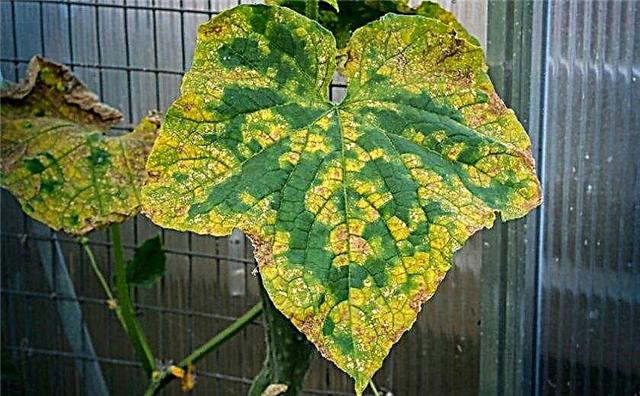
- White rot often occurs in greenhouses. On the affected fruit, a white mycelium of the fungus develops. To prevent infection, the soil is treated with Trichodermin. This is a highly effective drug. Its action is based on the introduction of a beneficial fungus into the soil, which destroys the pathogens of rot and creates a favorable environment for the development of beneficial microflora. Infected plants are destroyed, and the rest are treated with “Rowl” or “Sumilex”.
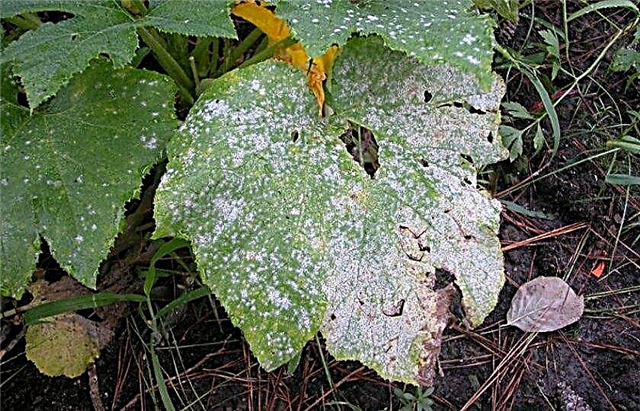
- Cladosporiosis or olive spotting often affects borage. On the outside of the leaves there are light brown spots with an olive border. Tumi variety is resistant to this disease.
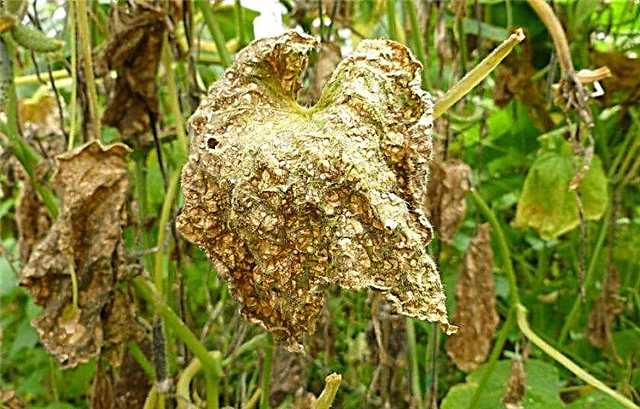
- Root rot Appears with improper watering. If moisture often stagnates at the roots, then the plants begin to fade and rot. To prevent the problem, control the temperature of the water and the frequency of watering. Destroy diseased plants.
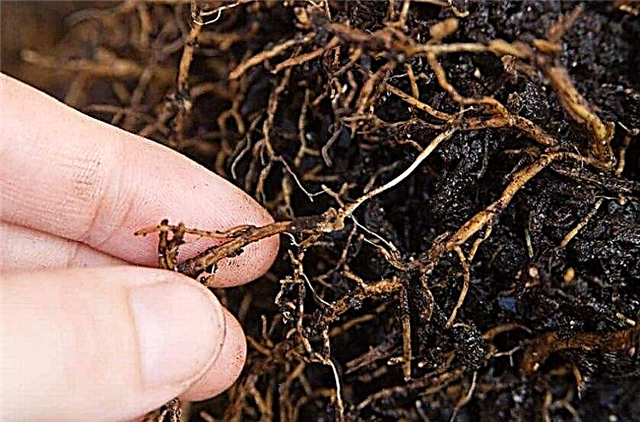
- Peronosporosis - This is a fungal disease, which manifests itself in the form of yellow spots on the leaves of a cucumber. For prophylaxis and treatment, spraying the borage with "Strobi" and "Quadris" preparations is used.
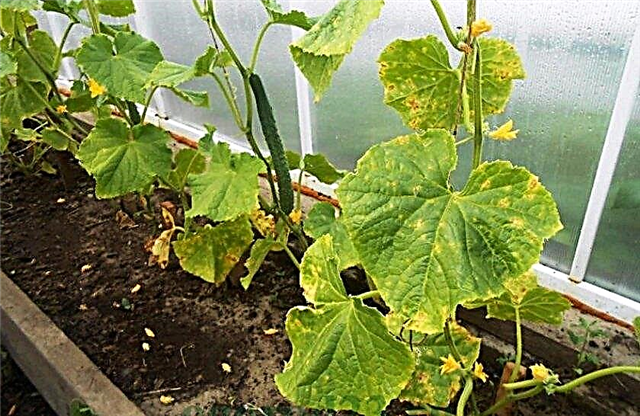
- Powdery mildew - the most common disease. It appears as a silver coating on the leaves. Tumi is also resistant to this disease.
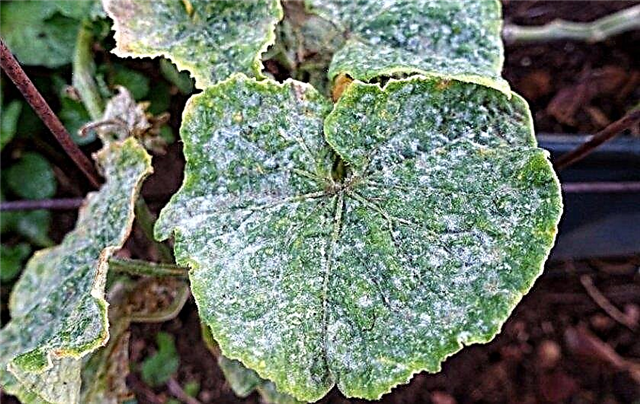
- Rhizoctonia or black scab forms black spots on leaves and fruits, which leads to the death of plant tissue. To prevent the disease, soil disinfection must be carried out, its treatment with preparations of the Trichodermin type. And plant protection is carried out by spraying with copper sulfate or "Ridomil Gold".
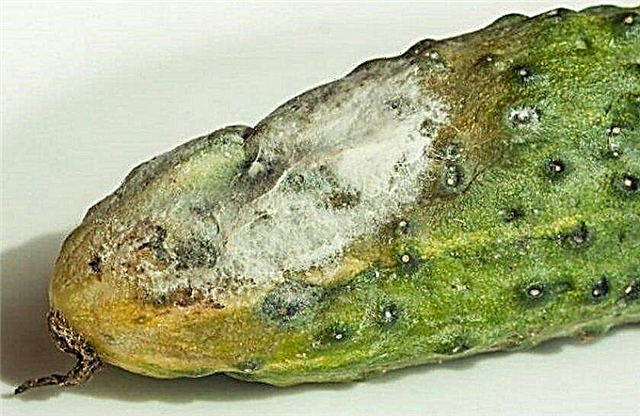
The main pests of cucumbers are aphids, ticks and other sucking insects. The result of their activity is leaf damage, a sticky coating that aphids leave. The insects themselves can often be found on the underside of the leaf. In this case, the crops are treated with appropriate insecticides.Did you know? If you place a few slices of cucumber in an aluminum container and place on the bed, then the smell obtained as a result of a chemical reaction will repel pests. People do not feel it, but insects catch it well.
The main pests:
Harvesting and storage
The fruits of cucumbers grow rapidly. Harvesting should be carried out regularly, starting from the moment of ripening of the first batch. Cucumber plants are able to control the formation of ovaries, so uncontrolled cucumbers delay the further formation of ovaries. Cucumbers are harvested in the morning, daily or every other day. The fruit is supported by hand and the tail secateurs are cut, leaving about 1.5 cm.
The collected cucumbers are stored for 7–10 days without loss of quality in a cool, dry room. The air temperature in it should not exceed + 10 ° C (in the basement, cellar). The box for cucumbers should have openings for airing vegetables. Zelentsy can be stored in a plastic bag in the refrigerator for about 14 days.
The package will not allow cucumbers to lose elasticity and wither. Caring for cucumbers is not too complicated. If the site for cultivation is correctly selected and the basic agricultural measures are followed, then you can collect a good crop of delicious vegetables.









